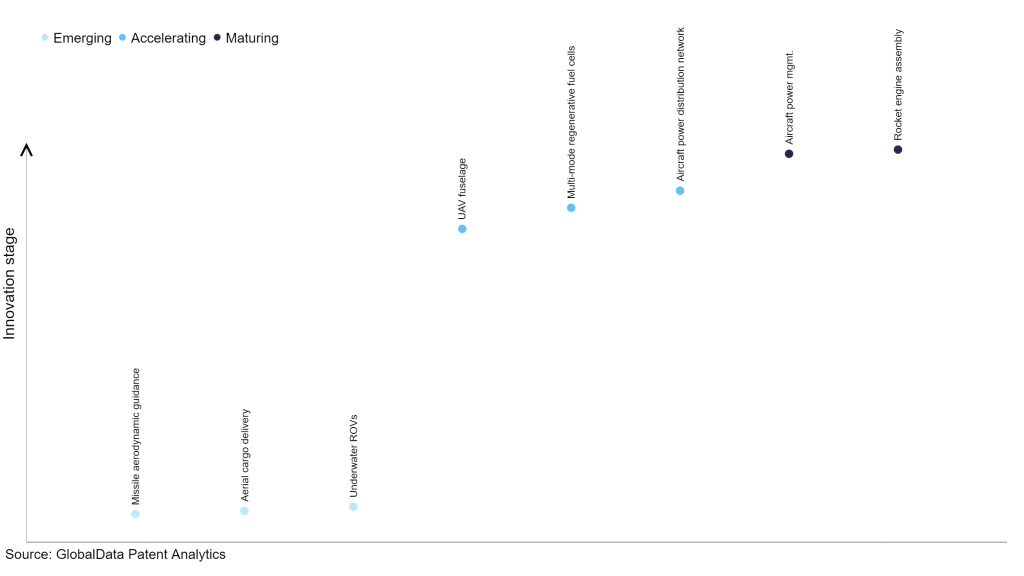The aerospace and defense industry continues to be a hotbed of patent innovation. Activity is driven by automation, environmental sustainability, and operational efficiency, and the growing importance of technologies such as artificial intelligence (AI), Internet of Things (IoT), drones, and satellites. In the last three years alone, there have been over 84,000 patents filed and granted in the aerospace and defense industry, according to GlobalData’s report on Innovation in defense: aircraft components 3D printing. Buy the report here.
However, not all innovations are equal and nor do they follow a constant upward trend. Instead, their evolution takes the form of an S-shaped curve that reflects their typical lifecycle from early emergence to accelerating adoption, before finally stabilizing and reaching maturity.
Identifying where a particular innovation is on this journey, especially those that are in the emerging and accelerating stages, is essential for understanding their current level of adoption and the likely future trajectory and impact they will have.
110 innovations will shape the aerospace and defense industry
According to GlobalData’s Technology Foresights, which plots the S-curve for the aerospace and defense industry using innovation intensity models built on over 260,000 patents, there are 110 innovation areas that will shape the future of the industry.
Within the emerging innovation stage, missile aerodynamic guidance, aerial cargo delivery, and underwater ROVs are disruptive technologies that are in the early stages of application and should be tracked closely. UAV fuselage, multi-mode regenerative fuel cells and aircraft power distribution network are some of the accelerating innovation areas, where adoption has been steadily increasing. Among maturing innovation areas are aircraft power management and rocket engine assembly, which are now well established in the industry.
Innovation S-curve for the aerospace and defense industry

Aircraft components 3D printing is a key innovation area in aerospace and defense
Aircraft components 3D printing refers to the process of using additive manufacturing techniques to create airplane parts and components. This process involves using digital models to produce complex, lightweight and efficient parts, which can significantly reduce costs and lead times in the maintenance, repair and overhaul of aircraft.
GlobalData’s analysis also uncovers the companies at the forefront of each innovation area and assesses the potential reach and impact of their patenting activity across different applications and geographies. According to GlobalData, there are 35+ companies, spanning technology vendors, established aerospace and defense companies, and up-and-coming start-ups engaged in the development and application of aircraft components 3D printing.
Key players in aircraft components 3D printing – a disruptive innovation in the aerospace and defense industry
‘Application diversity’ measures the number of applications identified for each patent. It broadly splits companies into either ‘niche’ or ‘diversified’ innovators.
‘Geographic reach’ refers to the number of countries each patent is registered in. It reflects the breadth of geographic application intended, ranging from ‘global’ to ‘local’.
Patent volumes related to aircraft components 3D printing
Source: GlobalData Patent Analytics
Airbus is one of the leading patent filers in aircraft components 3D printing. It filed patents related to the method and system of adapting a 3D printing model for use in additive layer manufacturing (ALM), selective laser sintering (SLS) and/or solid freeform fabrication (SFF) processes, and advanced 3D printing methods and apparatus for producing various aircraft components, including metal components and structural fiber-reinforced composite components for the fuselage of an aircraft or spacecraft.
The company is using 3D-printed lighter parts to retrofit aircraft and produce prototype airplanes and components, to reduce emissions, improve fuel and resource efficiency, and leverage the quick and highly flexible manufacturing capability.
Airbus Helicopters, the helicopter manufacturing division of Airbus, opened a new 3D printing center at its main helicopter production site in Donauworth, Germany, in October 2023. The company operates three types of 3D printing machines to produce composite components made of titanium, plastic, and aluminum.
Some other key patent filers in this space include Boeing, RTX, and Melrose Industries.
In terms of application diversity, Boeing, Airbus, and RTX are some of the leading innovators. By means of geographic reach, some of the leading patent filers include Melrose Industries, Continuous Composites, and General Electric.
To further understand the key themes and technologies disrupting the aerospace and defense industry, access GlobalData’s latest thematic research report on Aerospace & Defense.
Data Insights
From

The gold standard of business intelligence.
Blending expert knowledge with cutting-edge technology, GlobalData’s unrivalled proprietary data will enable you to decode what’s happening in your market. You can make better informed decisions and gain a future-proof advantage over your competitors.



